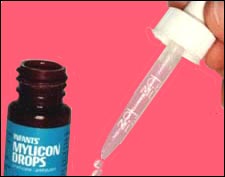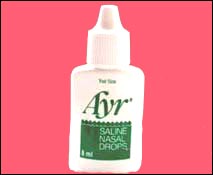방울약(적제약/점적약제), Drop medicines

사진 50. 마일로칸 방울약(적제약).
Copyright ⓒ 2011 John Sangwon Lee, MD., FAAP

사진 51. 비강 속에 넣을 수 있는 방울약(점적약제).
Copyright ⓒ 2011 John Sangwon Lee, MD., FAAP
- 여기에 있는 내용의 거의는 시럽 약(시럽제/단물 약), 엘릭서 약(엘릭시럽 약), 현탁액약 방울약의 내용과 거의 같다.
- 현탁액 약물(Suspension drugs)·시럽(Syrup)약·적제약(방울약/Drops)·엘릭서(Elixir)약 등 여러 종류의 액체 형태로 조제된 약들로 질병을 치료할 수 있다.
- 알약이나 캡슐 약을 삼킬 수 없는 어린 영유들이나 학령기 아이들이나 성인들의 일부는 병을 여러 종류의 액체 형태 약물 중 한 가지를 골라 병을 치료하고 예방할 수 있다.
- 어떤 액체 형태의 약물에 든 약물 성분이 물에는 잘 녹지 않기 때문에 소량의 알코올 성분을 가해서 제조하기도 한다. 그래서 액체 형태의 약물에 알코올 성분을 소량 첨가 한다. 이런 액체 형태의 약물을 엘릭서(Elixir)약물이라고 한다.
- 몹시 쓰거나 시어서 복용하기에 곤란한 약물을 경구용 액체 형태의 약물로 만들 때는 설탕, 꿀, 자당, 또는 그 외 다른 당질을 가미해서 만든 약을 “단물 약”, 시럽제 또는 시럽 약(Syrup)이라고 한다.
- 이렇게 액채 형태 약물에 당질을 가해 제조된 시럽약제, 점적약제 또는 현탁액약제 중 일부는 맛이 고약하고 몹시 써서 소아들이 먹기 싫어한다.
- 시럽약제나 현탁액약제 등으로 치료할 때 1회에 몇 cc, 몇 ㎖, 몇 티스푼(5㏄), 몇 테이블스푼(15㏄), 몇 드로퍼 또는 몇 방울(Drop), 몇 온스, 몇 컵(한 컵은 보통 240㏄) 등을 먹으라고 처방하는 것이 보통이다.
- 시럽약제나 엘릭시르제(엘릭서 약) 또는 현탁액제를 1회에 1 티스푼, 또는 1 테이블스푼의 용량을 1회에 먹으라고 처방할 때 1 티스푼(5㏄=5㎖)과 1 테이블스푼(15㏄=15㎖)을 혼동해서는 안 된다.
- 1 드롭(한 방울/One drop)과 1 드로퍼(한 스포이드/One dropper/One spoid)를 혼동해서도 안 된다.
- 대부분의 큰 유아들은 액체 형태 약물 1 티스푼이나 1 테이블스푼을 한 번에 다 넘길 수 있지만 아주 어린 영유들은 1 티스푼(One teaspoon)이나 1 테이블스푼(One table spoon)의 1회분 량 액체형태의 약물을 한 번에 다 넘길 수 없다. 더군다나 쓰고 신 약물은 더 그럴 수 있다.
액체형태 약물 투약 방법
- 시럽약제나 현탁액제를 1회 1 티스푼이나 1 테이블스푼을 어린 영유아에게 먹일 때는 다음과 같이 먹여 본다.
- 영유아의 머리를 엄마의 무릎 위에 몸통 높이 보다 좀 더 높게 눕히든지 무릎 위에 앉힌다.
- 신생아기 때부터 가능한 한 약물을 먹이기 전에 약물을 먹어야 하는 이유를 간단히 설명한 다음 약물을 먹여야 한다.
- 엄마의 말을 잘 알아듣고 협조적이고 먹으라고 주는 약물을 잘 받아먹을 수 있으면 의사가 처방한 대로 1 티스푼이나 1 스포이트(드로퍼) 등 1회분 량 한 티스푼이나 한 테이블스푼의 약물을 한 입에다 다 넣어 먹이든지 한 티스푼이나 한 테이블스푼의 일부분을 입안이나 혓바닥 밑에 떨어트려 먹일 수 있다.
- 말을 잘 알아듣지도 못하고 비협조적이고 입을 벌리지 않는 아주 어린아이에게 시럽약제, 현탁액제나 점적약제를 먹일 때는 두 볼을 한쪽 손 엄지와 인지손가락으로 살짝 눌러 입을 조금 벌리고 한두 방울씩 약물을 입 안에 넣어 먹일 수 있다.
- 특히 영유아들에게 액체형태의 약물을 먹일 때 쉽게 먹일 수 있게 만든 여러 종류의 약물 투여기구로 먹일 수 있다.
- 이런저런 방법으로 경구용 약물을 먹일 수 없으면 때로는 경구용 약물 대신 주사용 약물이나 좌약 등으로 치료하는 경우도 있다.
Drop medicines (drop medicine/drop medicine)

Photo 50. Mylocan drops (Juk Pharmaceutical). Copyright ⓒ 2011 John Sangwon Lee, MD., FAAP

Picture 51. Drops (drops) that can be placed in the nasal cavity. Copyright ⓒ 2011 John Sangwon Lee, MD., FAAP
• Most of the contents here are the same as the contents of syrup medicine (syrup/sweet solution), elixirs (elixiup medicine), and suspension medicine drop.
• Suspension drugs, Syrup drugs, Drops (Drops), Elixir drugs, etc. can be treated with various types of drugs formulated in liquid form.
• Some young children, school-age children, or adults who cannot swallow pills or capsules can take one of several liquid medications to treat and prevent illness.
• In any liquid form of the drug, the drug component is not soluble in water, so a small amount of alcohol is added to it. Therefore, a small amount of alcohol is added to the drug in liquid form. These liquid drugs are called Elixir drugs
. • When a drug that is very bitter or sour and difficult to take is made into an oral liquid drug, a drug made with sugar, honey, sucrose, or other sugar added is called a “sweet solution”, syrup or syrup. do.
• Some of the syrups, drops, or suspensions prepared by adding sugar to liquid drugs have a bad taste and are very bitter, so children do not like to eat them.
• When treating with syrup or suspension, several cc, several ml, several teaspoons (5 cc), several tablespoons (15 cc), several droppers or several drops, several ounces, several cups (one The cup is usually 240㏄) and it is usually prescribed to eat.
• When prescribing a syrup or elixirs (elixirs) or suspension to take 1 teaspoon or 1 tablespoon at a time, 1 teaspoon (5cc = 5ml) and 1 tablespoon (15 cc) ㏄ = 15ml) should not be confused.
• Do not confuse 1 drop (One drop/One drop) with 1 dropper (One dropper/One spoid).
• Most older infants can take 1 teaspoon or 1 tablespoon of liquid medication at a time, but very young infants can take 1 teaspoon or 1 table spoon of liquid medication. cannot pass all at once. Worse, bitter and sour drugs can be even more so.
How to administer liquid drugs
• When feeding 1 teaspoon or 1 tablespoon of syrup or suspension to young children, try the following.
• Place the infant’s head on the mother’s lap a little higher than torso level or sit on the lap. • If possible from the time of newborn, the drug should be administered after briefly explaining why the drug should be taken before the drug is given.
• If you can understand your mother’s words, be cooperative, and take the medication she is giving you, take 1 teaspoon or 1 teaspoon of the medication in one mouthful, such as 1 teaspoon or 1 dropper, as prescribed by your doctor. You can feed them by feeding them in, or you can drop a teaspoon or a portion of a tablespoon into your mouth or under your tongue.
• When giving syrup, suspension, or drops to a very young child who cannot understand speech, is uncooperative and does not open his mouth, gently press both cheeks with the thumb and forefinger of one hand to open the mouth slightly, and insert the drug one or two drops at a time. can be fed
• In particular, when feeding liquid drugs to infants and young children, it can be fed with a variety of drug administration devices that can be easily fed.
• If oral medications cannot be administered in one way or another, sometimes injections or suppositories are used instead of oral medications.
출처 및 참조 문헌
-
Oral Health The Pediatric Clinics of North America, Stuart D.Josell
-
Pediatric Oral Health Stuart Jose
-
Ann L. Griffen, DDS, MS
-
Atlas Pediatric Physical Diagnosis Frank A Oski
- www.drleepediatrics.com 제1권 소아청소년 응급 의료
- www.drleepediatrics.com 제2권 소아청소년 예방
- www.drleepediatrics.com 제3권 소아청소년 성장 발육 육아
- www.drleepediatrics.com 제4권 모유,모유수유, 이유
- www.drleepediatrics.com 제5권 인공영양, 우유, 이유식, 비타민, 미네랄, 단백질, 탄수화물, 지방
- www.drleepediatrics.com 제6권 신생아 성장 발육 육아 질병
- www.drleepediatrics.com제7권 소아청소년 감염병
- www.drleepediatrics.com제8권 소아청소년 호흡기 질환
- www.drleepediatrics.com제9권 소아청소년 소화기 질환
- www.drleepediatrics.com제10권. 소아청소년 신장 비뇨 생식기 질환
- www.drleepediatrics.com제11권. 소아청소년 심장 혈관계 질환
- www.drleepediatrics.com제12권. 소아청소년 신경 정신 질환, 행동 수면 문제
- www.drleepediatrics.com제13권. 소아청소년 혈액, 림프, 종양 질환
- www.drleepediatrics.com제14권. 소아청소년 내분비, 유전, 염색체, 대사, 희귀병
- www.drleepediatrics.com제15권. 소아청소년 알레르기, 자가 면역질환
- www.drleepediatrics.com제16권. 소아청소년 정형외과 질환
- www.drleepediatrics.com제17권. 소아청소년 피부 질환
- www.drleepediatrics.com제18권. 소아청소년 이비인후(귀 코 인두 후두) 질환
- www.drleepediatrics.com제19권. 소아청소년 안과 (눈)질환
- www.drleepediatrics.com 제20권 소아청소년 이 (치아)질환
- www.drleepediatrics.com 제21권 소아청소년 가정 학교 간호
- www.drleepediatrics.com 제22권 아들 딸 이렇게 사랑해 키우세요
- www.drleepediatrics.com 제23권 사춘기 아이들의 성장 발육 질병
- www.drleepediatrics.com 제24권 소아청소년 성교육
- www.drleepediatrics.com 제25권 임신, 분만, 출산, 신생아 돌보기
- Red book 29th-31st edition 2021
- Nelson Text Book of Pediatrics 19th- 21st Edition
- The Johns Hopkins Hospital, The Harriet Lane Handbook, 22nd edition
- 응급환자관리 정담미디어
- Pediatric Nutritional Handbook American Academy of Pediatrics
- 소아가정간호백과–부모도 반의사가 되어야 한다, 이상원 저
- The pregnancy Bible. By Joan stone, MD. Keith Eddleman, MD
- Neonatology Jeffrey J. Pomerance, C. Joan Richardson
- Preparation for Birth. Beverly Savage and Dianna Smith
- 임신에서 신생아 돌보기까지. 이상원
- Breastfeeding. by Ruth Lawrence and Robert Lawrence
- Sources and references on Growth, Development, Cares, and Diseases of Newborn Infants
- Emergency Medical Service for Children, By Ross Lab. May 1989. p.10
- Emergency care, Harvey Grant and Robert Murray
- Emergency Care Transportation of Sick and Injured American Academy of Orthopaedic Surgeons
- Emergency Pediatrics A Guide to Ambulatory Care, Roger M. Barkin, Peter Rosen
- Quick Reference To Pediatric Emergencies, Delmer J. Pascoe, M.D., Moses Grossman, M.D. with 26 contributors
- Neonatal resuscitation Ameican academy of pediatrics
- Pediatric Nutritional Handbook American Academy of Pediatrics
- Pediatric Resuscitation Pediatric Clinics of North America, Stephen M. Schexnayder, M.D.
-
Pediatric Critical Care, Pediatric Clinics of North America, James P. Orlowski, M.D.
-
Preparation for Birth. Beverly Savage and Dianna Smith
-
Infectious disease of children, Saul Krugman, Samuel L Katz, Ann A.
-
Emergency Care Transportation of Sick and Injured American Academy of Orthopaedic Surgeons
-
Emergency Pediatrics A Guide to Ambulatory Care, Roger M. Barkin, Peter Rosen
-
Gray’s Anatomy
-
제19권 소아청소년 안과 질환 참조문헌 및 출처
- Habilitation of The handicapped Child, The Pediatric Clinics of North America, Robert H Haslam, MD.,
-
Pediatric Ophthalmology, The Pediatric Clinics of North America, Leonard B. Nelson, M.D.
-
Pediatric Ophthalmology, The Pediatric Clinics of North America, Lois J. Martyn, M.D.
-
Pediatric Ophthalmology, Edited by Robison D. Harley, M.D.
-
The Pediatric Clinics of North America, David Tunkel, MD., Kenneth MD Grundfast, MD
Copyright ⓒ 2014 John Sangwon Lee, MD., FAAP
“부모도 반의사가 되어야 한다”-내용은 여러분들의 의사로부터 얻은 정보와 진료를 대신할 수 없습니다.
“The information contained in this publication should not be used as a substitute for the medical care and advice of your doctor. There may be variations in treatment that your doctor may recommend based on individual facts and circumstances.
“Parental education is the best medicine.